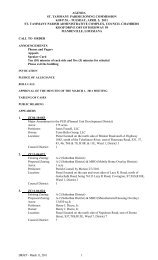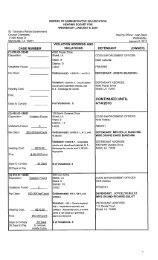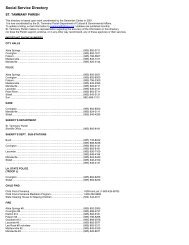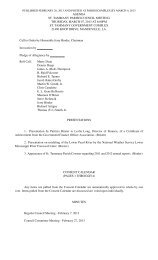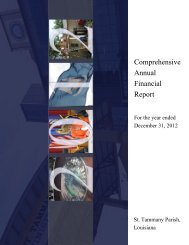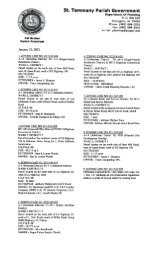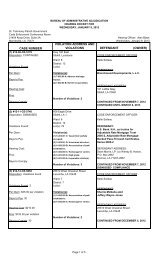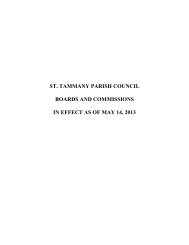Comprehensive Annual Financial Report - St. Tammany Parish ...
Comprehensive Annual Financial Report - St. Tammany Parish ...
Comprehensive Annual Financial Report - St. Tammany Parish ...
Create successful ePaper yourself
Turn your PDF publications into a flip-book with our unique Google optimized e-Paper software.
ST. TAMMANY PARISH GOVERNMENT<br />
Notes to the <strong>Financial</strong> <strong>St</strong>atements 2010<br />
Post employment Benefit Plan Eligibility Requirements. Based on past experience, it has been assumed that entitlement<br />
to benefits will commence three years after satisfaction of the eligibility provisions. The three year delay is to<br />
accommodate the D.R.O.P. period. Medical benefits are provided to employees upon actual retirement. The retirement<br />
eligibility (D.R.O.P. entry) provisions are as follows: the earliest of 30 years of service; age 55 and 25 years of service; age<br />
60 and 10 years of service; or, age 65 and 7 years of service. Complete plan provisions are contained in the official plan<br />
documents. Entitlement to benefits continues through Medicare to death.<br />
Investment Return Assumption (Discount Rate). GASB <strong>St</strong>atement 45 states that the investment return assumption<br />
should be the estimated long-term investment yield on the investments that are expected to be used to finance the payment<br />
of benefits (that is, for a plan which is funded). Based on the assumption that the ARC will not be funded, a 4% annual<br />
investment return has been used in this valuation. This is a conservative estimate of the expected long term return of a<br />
balanced and conservative investment portfolio under professional management.<br />
Health Care Cost Trend Rate. The expected rate of increase in medical cost is based on projections performed by the<br />
Office of the Actuary at the Centers for Medicare & Medicaid Services as published in National Health Care Expenditures<br />
Projections: 2003 to 2013, Table 3: National Health Expenditures, Aggregate and per Capita Amounts, Percent<br />
Distribution and Average <strong>Annual</strong> Percent Change by Source of Funds: Selected Calendar Years 1990-2013, released in<br />
January, 2004 by the Health Care Financing Administration (www.cms.hhs.gov). "<strong>St</strong>ate and Local" rates for 2008 through<br />
2013 from this report were used, with rates beyond 2013 graduated down to an ultimate annual rate of 5.0% for 2016 and<br />
later.<br />
Mortality Rate. The 1994 Group Annuity Reserving (94GAR) table, projected to 2002, based on a fixed blend of 50% of<br />
the unloaded male mortality rate and 50% of the unloaded female mortality rates, was used. This is a published mortality<br />
table which was designed to be used in determining the value of accrued benefits in defined benefit pension plans.<br />
Method of Determining Value of Benefits. The "value of benefits" has been assumed to be the portion of the premium<br />
after the retirement date expected to be paid by the employer for each retiree and has been used as the basis for calculating<br />
the actuarial present value of OPEB benefits to be paid. The medical rates provided are "blended" rates for active and<br />
retired prior to Medicare eligibility. We have, therefore, estimated the total “unblended” rates as required by GASB 45 for<br />
valuation purposes to be 130% of the blended rates prior to Medicare eligibility. The appropriate percentage of the blended<br />
rate paid by the retiree (one minus the percentage paid by the employer) was then deducted from the gross unblended rate<br />
to determine the resulting employer contribution. After Medicare eligibility at age 65, the rates provided are “unblended”<br />
rates, as mandated by GASB 45, and vary by five-year age brackets from $346.64 monthly for ages 66 to 69 up to $512.04<br />
monthly for ages over 85. It has been assumed that 50% of retirees would decline coverage upon Medicare eligibility<br />
(typically at age 65) because of the premium size required of the retiree.<br />
G. Other Post-Employment Benefits<br />
The <strong>Parish</strong> provides a Post-employment Health Plan (the Plan) for employees hired by the <strong>Parish</strong>. The Plan provides for<br />
individual employee accounts, in which the funds within these accounts can be used for post-employment medical<br />
premiums and expenses.<br />
Employees with three or more years of service who resign or retire are paid for one-third of their accumulated sick time.<br />
An employee with ten or more years of service who resigns or retirees, the remaining two-thirds of sick leave is deposited<br />
into individual employee accounts for post-employment health costs. At December 31, 2010, the estimated liability<br />
associated with post-employment health benefits is $682,550, and is recognized in the Post-employment Health Plan<br />
internal service fund.<br />
77



